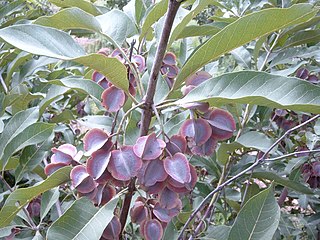
Loranthaceae, commonly known as the showy mistletoes, is a family of flowering plants. It consists of about 75 genera and 1,000 species of woody plants, many of them hemiparasites. The three terrestrial species are Nuytsia floribunda, Atkinsonia ligustrina, and Gaiadendron punctatum Loranthaceae are primarily xylem parasites, but their haustoria may sometimes tap the phloem, while Tristerix aphyllus is almost holoparasitic. For a more complete description of the Australian Loranthaceae, see Flora of Australia online., for the Malesian Loranthaceae see Flora of Malesia.

Basilicum is a genus of plants in the Lamiaceae, first described in 1802. It contains only one known species, Basilicum polystachyon, native to Africa, Madagascar, southern Asia, New Guinea, Australia, and various islands of the Pacific and Indian Oceans.

Tapinanthus is a genus of mistletoe in the family Loranthaceae, endemic to Africa. The name of the genus is derived from the Greek tapeinos meaning "low" or "humble" and anthos meaning flower.

Agelanthus is a genus of Afrotropical plants in family Loranthaceae. They grow in trees, including Acacia and Combretum species, as hemiparasitic shrubs of varying sizes. The host plant is penetrated by a single haustorium, and the stems typically have swollen, flower-producing nodes. The flowers are often closely clustered (fascicled) with the five petals (pentamerous) fused into a tube (gamopetalous). The flower may have a swollen base and the tubes open along unilateral, V-shaped splits. The filaments remain spirally rolled inward when the flowers open, while the styles are inconspicuous, slender filaments that are somewhat thickened in the middle. Berries range from pink to orange and red in colour, and are around 1 cm in diameter.

The blue-leaved mistletoe is a species of perennial, parasitic plant in the family Loranthaceae, which is native to the southeastern Afrotropics.
Agelanthus rondensis is a species of hemiparasitic plant in the Loranthaceae family. It is endemic to Tanzania.
Agelanthus atrocoronatus is a species of hemiparasitic plant in the Loranthaceae family. It is endemic to Tanzania. It is known only from the Mufindi Plateau in Tanzania, and was last collected in the 1980s.
Agelanthus kayseri is a species of hemiparasitic plant in the Loranthaceae family, which is native to Kenya, Tanzania and Somalia.
Agelanthus keilii is a species of hemiparasitic plant in the Loranthaceae family, which is native to Rwanda, Tanzania and Burundi.
Agelanthus igneus is a species of hemiparasitic plant in the Loranthaceae family, which is native to Mozambique and Tanzania.
Agelanthus microphyllus is a species of hemiparasitic plant in the Loranthaceae family, which is native to Ethiopia, Kenya and Tanzania.
Agelanthus uhehensis is a species of hemiparasitic plant in the Loranthaceae family, which is native to Tanzania.
Agelanthus validus is a species of hemiparasitic plant in the Loranthaceae family, which is found in the Usambara Mountains, Tanzania
Agelanthus longipes is a species of hemiparasitic plant in the Loranthaceae family, which is found in the Tanzania, Mozambique and Kenya.
Agelanthus pennatulus is a species of hemiparasitic plant in the family Loranthaceae, which is found in Tanzania, and Kenya.
Agelanthus myrsinifolius is a species of hemiparasitic plant in the family Loranthaceae, which is native to Rwanda, Zaire and Burundi.
Agelanthus nyasicus is a species of hemiparasitic plant in the family Loranthaceae, which is native to Botswana, Malawi, Mozambique, Tanzania, Zambia, Zaïre and Zimbabwe.

Tristerix aphyllus is a holoparasitic plant species of the genus Tristerix in the family Loranthaceae. It is endemic to Chile. T. aphyllus is sometimes called the "cactus mistletoe." It should not be confused with the mistletoe cactus, which is an epiphytic cactus, and not a mistletoe.

Muellerina myrtifolia, common name myrtle-leaved mistletoe, is a hemiparasitic arial shrub in the family Loranthaceae. The species is endemic to New South Wales and Queensland.













